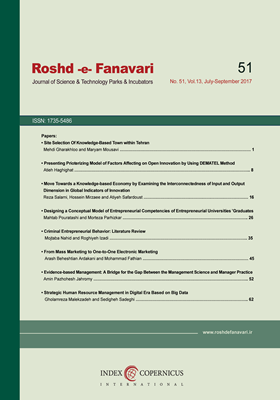-
-
List of Articles
-
Open Access Article
1 - Designing a Conceptual Model of Entrepreneurial Competencies of Entrepreneurial Universities’ Graduates
Mahtab Pouratashi Morteza Parhizkar -
Open Access Article
2 - Presenting Prioterizing Model of Factors Affecting on Open Innovation by Using DEMATEL Method
atiyeh haghighat -
Open Access Article
3 - Site Selection Of Knowledge-Based Town within Tehran
Mehdi Gharakhloo Maryam Mousavi -
Open Access Article
4 - Move Towards a Knowledge-based Economy by Examining the Interconnectedness of Input and Output Dimension in Global Indicators of Innovation
reza salami hossien mirzaee atiyeh safardoust -
Open Access Article
5 - Evidence-based Management: A Bridge for the Gap Between the Management Science and Manager Practice
Amin Pazhohesh Jahromy -
Open Access Article
6 - Strategic Human Resource Management in Digital Era Based on Big Data
Gholamreza Malekzadeh sedigheh sadeghi -
Open Access Article
7 - Criminal Entrepreneurial Behavior: Literature Review
Mojtaba Nahid Roghayeh izadi -
Open Access Article
8 - From Mass Marketing to One-to-One Electronic Marketing
Arash Beheshtian-Ardakani Mohammad fathiyan
-
The rights to this website are owned by the Raimag Press Management System.
Copyright © 2017-2025







